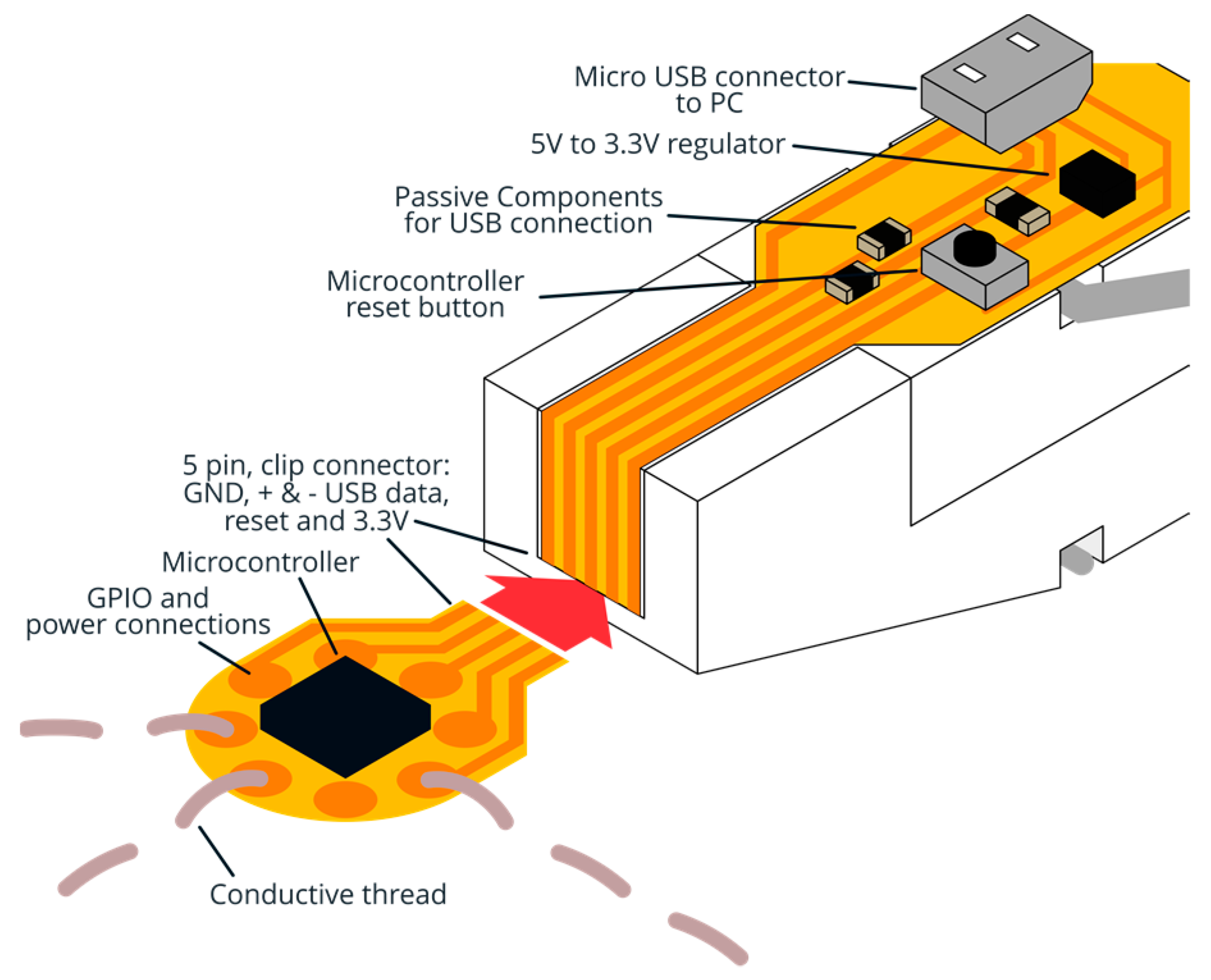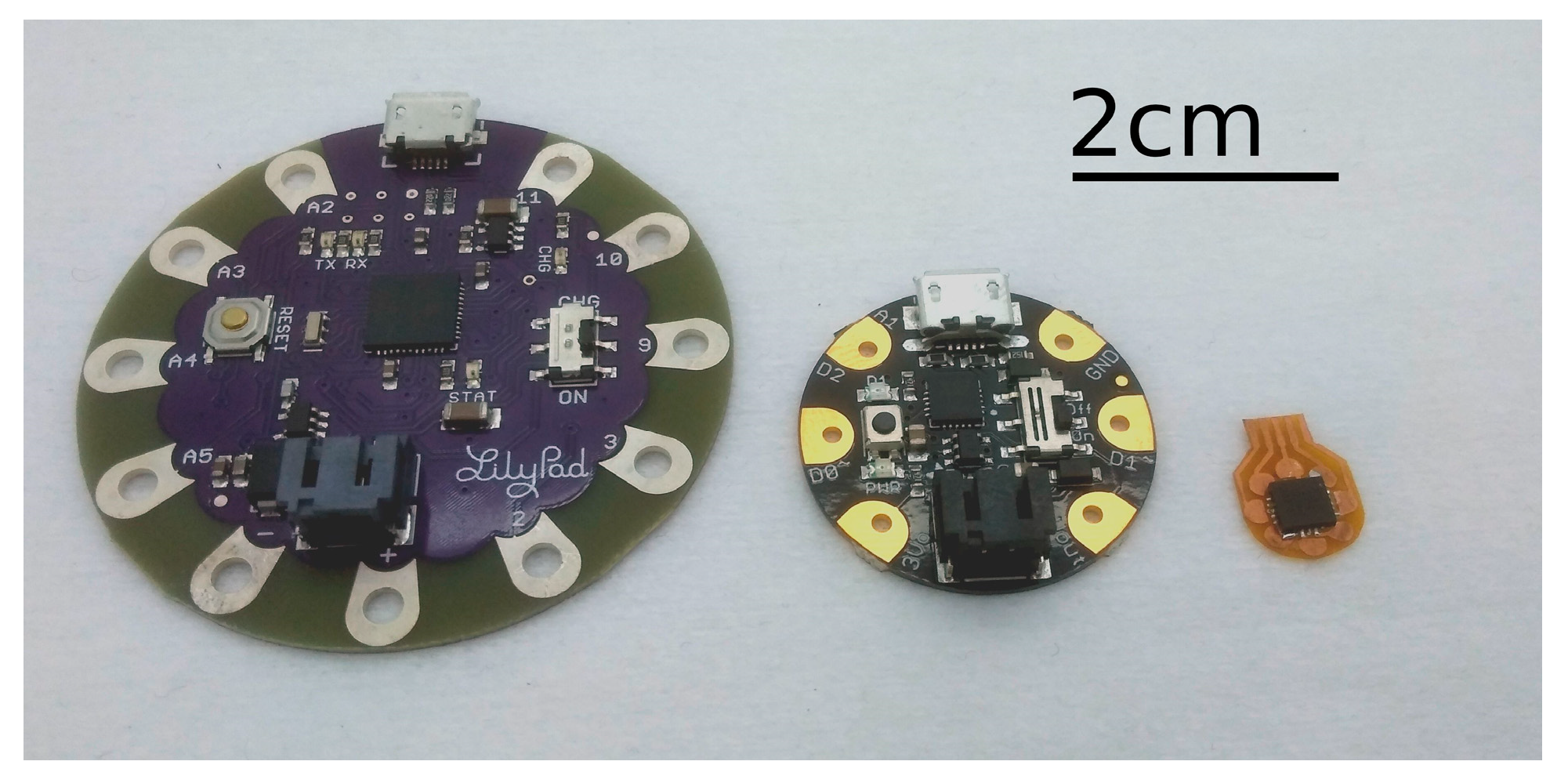1. Introduction
Microcontrollers are vital components in many e-textile devices [
1,
2]. Their re-programmability and wide range of peripheral functions means that they can fulfil the digital processing requirements of almost any small electronic product while their small size makes them possible to include in e-textile devices.
The ability to be re-programmed is key to a microcontroller’s utility, and most provide some means of uploading new programs while in situ, for example, AVRs’ SPI-based “ICSP” protocol [
3]. However, such systems typically only work on one brand of microcontroller and require specialised programming circuits to use. The connectors required to use these systems also occupy a large area: the pin header needed to connect the ATMEL ICE programmer to a QFN ATtiny occupies 4 times the area and 12 times the height of the chip itself, see
Figure 1.
The first problem can be solved using a USB bootloader. This is a small program which is used to load new software via a USB connection.
However, even micro-USB connectors are relatively large components in the context of e-textiles and restrict the textile integration of a microcontroller circuit. A potential solution to this is to use an edge connector. These consist of a series of exposed pads near the edge of the circuit board. The board itself is then inserted into a receptacle with contacts arranged to connect with the pads. However, existing solutions are for typically thicker (0.3 mm) flat flexible cables (FFC), therefore connections can be difficult and unreliable.
2. Design
The system developed here uses five, 1 mm pitch, pads which need only protrude a few millimetres from the body of a flexible circuit board connect to an external clip. The five connections are used for power, ground, positive and inverted USB data and a button-operated reset line which prompts the microcontroller to run its bootloader. The clip contains all the additional components needed for USB programming: the micro-USB connector, a 3.3 V voltage regulator, a reset button and several passive components. A diagram of this system is shown in
Figure 2.
The contacts on both sides are tinned with solder to prevent corrosion This system was tested using an ATTiny85 microcontroller [
3] with the micronucleus bootloader [
4]. Both the flexible microcontroller circuit board and the programming clip’s PCB were made using a standard photolithographic etching process described previously in [
5].
The contacts on both sides are tinned with a thin layer of solder to prevent corrosion and to raise the contact point slightly, making the connection more reliable.
3. Applications
The test implementation was incorporated into both woven (
Figure 3, top left) and stretchable, knitted fabrics (
Figure 3, right) by couching the conductive thread soldered to the general purpose input/output (GPIO) pins for the controller. Another version was made by inserting the device and its connecting wires into woven pockets in a custom-made fabric (
Figure 3, bottom left).
Because of its small size, the impact on the flexibility and stretchability of the fabric is minor. This is a major improvement over existing prototyping boards designed for e-textile which are much larger and used rigid PCBs (
Figure 4).
This programming system can easily be adapted to other microcontrollers which are reprogrammable via USB.
4. Conclusions
This work presents an easy-to-use programmer, compatible with many different types of microcontrollers. It occupies significantly less circuit board space than existing commercial equivalents, the prototype displayed here is 80% smaller than an Adafruit Gemma and requires no additional components on the microcontroller board itself.
This is important in e-textile applications where a large size or additional rigid components can compromise the textile’s properties of comfort and flexibility.
The small connector size and minor impact on integration mean that, when moving beyond the prototyping stage, the connector footprint may not need to be removed, and if it is, only a small change to the circuit layout is needed. The initial demonstrators also show that this methodology of flexible microcontroller integration and flexible connection point works with both couching into existing garment structures and integration during weaving.
Author Contributions
Conceptualization, investigation, writing—original draft preparation, T.G.; supervision, writing—review and editing, K.Y. and R.T. All authors have read and agreed to the published version of the manuscript.
Funding
This research was part-funded by EPSRC grant number EP/S001654/1, “Advanced e-textiles for wearable therapeutics” and part-funded by the EU H2020 programme, grant number WEARPLEX—825339—
wearplex.soton.ac.uk.
Data Availability Statement
No new data was created or analysed in the study.
Conflicts of Interest
The authors declare no conflict of interest.
References
- Castano, L.M.; Flatau, A.B. Smart fabric sensors and e-textile technologies: A review. Smart Mater. Struct. 2014, 23, 053001. [Google Scholar] [CrossRef]
- Komolafe, A.; Zaghari, B.; Torah, R.; Weddell, A.S.; Khanbareh, H.; Tsikriteas, Z.M.; Vousden, M.; Wagih, M.; Jurado, U.T.; Beeby, S.; et al. E-Textile Technology Review–From Materials to Application. IEEE Access 2021, 9, 97152–97179. [Google Scholar] [CrossRef]
- Datasheet for ATtiny85 Microcontroller from Microchip. Available online: https://www.microchip.com/en-us/product/ATtiny85 (accessed on 2 December 2022).
- Micronucleus Bootloader Software for ATtiny85 USB Programming. Available online: https://www.github.com/micronucleus/micronucleus (accessed on 2 December 2022).
- Komolafe, A.; Torah, R.; Wei, Y.; Nunes-Matos, H.; Li, M.; Hardy, D.; Dias, T.; Tudor, M.; Beeby, S. Integrating Flexible Filament Circuits for E-Textile Applications. Adv. Mater. Technol. 2019, 4, 1900176. [Google Scholar] [CrossRef]
- Arduino Lilypad USB Documentation. Available online: https://docs.arduino.cc/retired/boards/lilypad-arduino-usb (accessed on 5 December 2022).
- Adafruit Gemma v2 Product Page. Available online: https://www.adafruit.com/product/1222 (accessed on 5 December 2022).
| Disclaimer/Publisher’s Note: The statements, opinions and data contained in all publications are solely those of the individual author(s) and contributor(s) and not of MDPI and/or the editor(s). MDPI and/or the editor(s) disclaim responsibility for any injury to people or property resulting from any ideas, methods, instructions or products referred to in the content. |
© 2023 by the authors. Licensee MDPI, Basel, Switzerland. This article is an open access article distributed under the terms and conditions of the Creative Commons Attribution (CC BY) license (https://creativecommons.org/licenses/by/4.0/).










